NVIDIA LaunchPad + NVIDIA AI Enterprise
What is NVIDIA LaunchPad
NVIDIA LaunchPad is a free program that provides users short-term access to a large catalog of hands-on labs. Enterprises and organizations can immediately tap into the necessary hardware and software stacks to experience end-to-end solution workflows in the areas of AI, data science, 3D design collaboration and simulation, and more.
What to Expect on NVIDIA LaunchPad
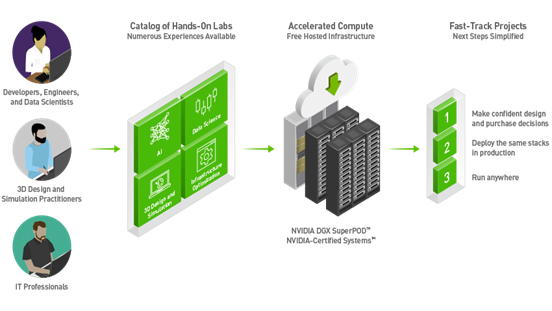
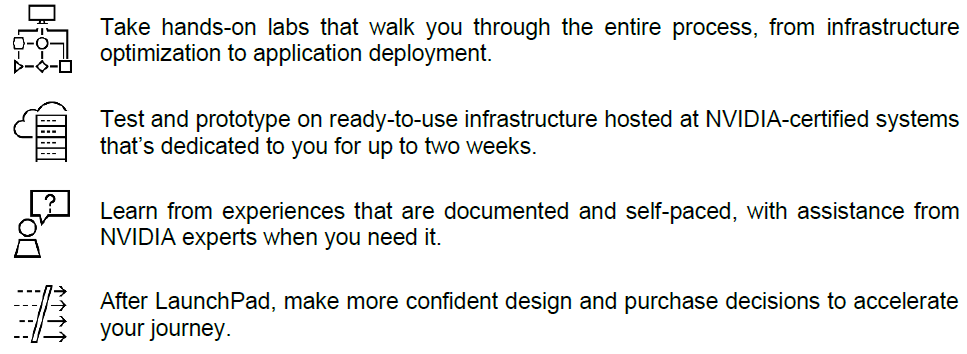
What is NVIDIA AI Enterprise
NVIDIA AI Enterprise Catalog gives you the entire access to an end-to-end, cloud-native, suite of AI and data analytics software, optimized and certified by NVIDIA. It’s certified to deploy anywhere—from the enterprise data center to the public cloud—and includes global enterprise support and training. It includes key enabling technologies and software from NVIDIA for rapid deployment, management, and scaling of AI workloads in the modern hybrid cloud.
NVIDIA AI Enterprise enables the following:
- Leverage fully integrated, optimized, certified, and supported software from NVIDIA for AI workloads.
- Run NVIDIA AI frameworks and tools optimized for GPU acceleration, reducing deployment time and ensuring reliable performance.
- Deploy anywhere – including on popular data center platforms from VMware and Red Hat, mainstream NVIDIA-Certified Systems configured with or without GPUs, and on GPU-accelerated instances in the public cloud.
- Leverage the jointly certified NVIDIA and Red Hat solution to deploy and manage AI workloads in containers or VMs with optimized software.
- Scale out to multiple nodes, enabling even the largest deep learning training models to run on the VMware vSphere. Previously, scaling with bare metal performance in a fully virtualized environment was limited to a single node, limiting the complexity and size of AI workloads that could be supported.
- Run AI workloads at near bare-metal performance with new optimizations for GPU acceleration on vSphere, including support for the latest Ampere architecture including the NVIDIA A100. Additionally, technologies like GPUDirect Communications can now be supported on vSphere. This provides communication between GPU memory and storage across a cluster for improved performance.
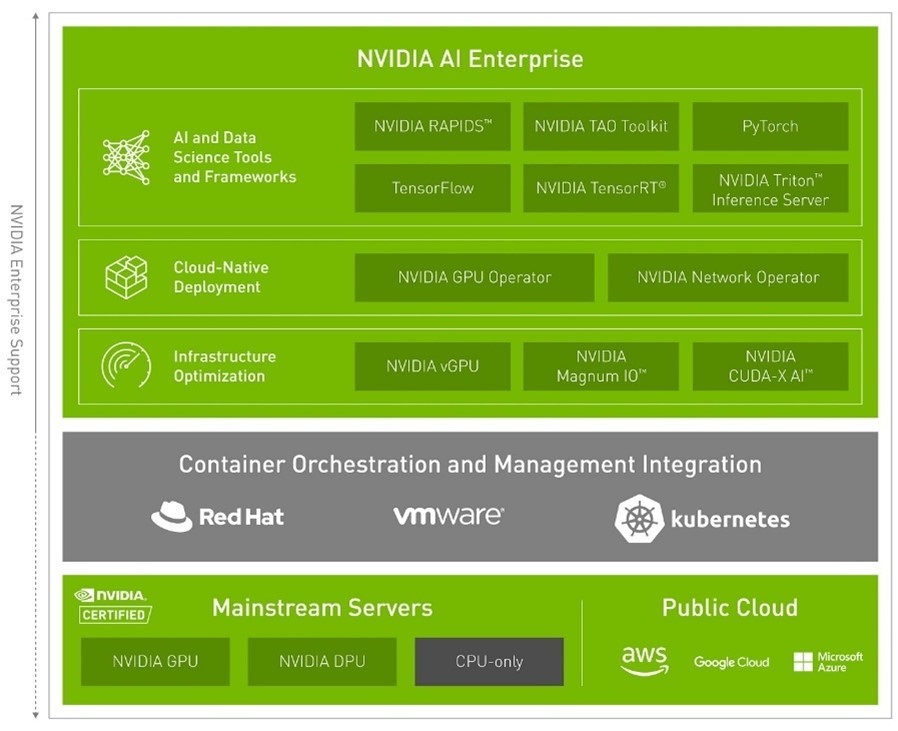
The NVIDIA AI Enterprise includes:
- TensorFlow and Pytorch for machine learning
- NVIDIA TAO Toolkit for a faster, easier way to accelerate training and quickly create highly accurate and performant, domain-specific vision, and conversational AI models
- NVIDIA Tensor RT, for GPU optimized deep learning inference and Triton Inference Server to deploy trained AI models at scale
- Triton Inference Server supports all major frameworks, such as TensorFlow, TensorRT, PyTorch, MXNet, Python and more. Triton Inference Server also includes the RAPIDS FIL backend for the best inference performance for tree-based models on GPUs.
- NVIDIA RAPIDS, for end-to-end data science, machine learning and analytics pipeline
- NVIDIA GPU and Network Operators, to deploy and manage NVIDIA GPU and Networking resources in Kubernetes
- NVIDIA vGPU Software, to deploy vGPU on common data center platforms, including VMware and Red Hat
Deploying NVIDIA AI Enterprise on NVIDIA LaunchPad
Through the LaunchPad portal, NVIDIA provides a series of steps that you can follow to install the NVIDIA AI Enterprise software stack. For example, below demonstration is to “Train and Deploy an AI Support Chatbot” using TensorFlow, TensorRT and Triton Inference Server from the NVIDIA AI Enterprise Catalog.
- Connect to the VMware vCenter
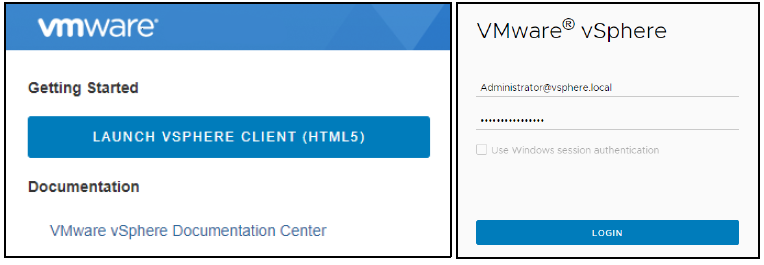
2. Create Your First NVIDIA AI Enterprise VM and install the Operating System. We also added an NVIDIA Virtual GPU device to the VM to accelerate the workloads later on.
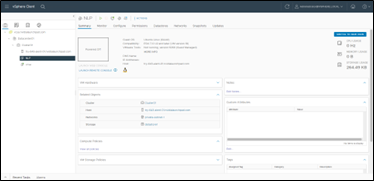

3. Installing Docker and Docker Utility Engine for NVIDIA GPUs
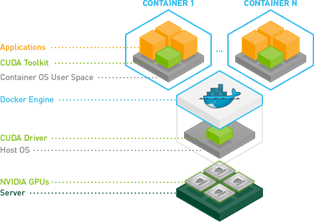
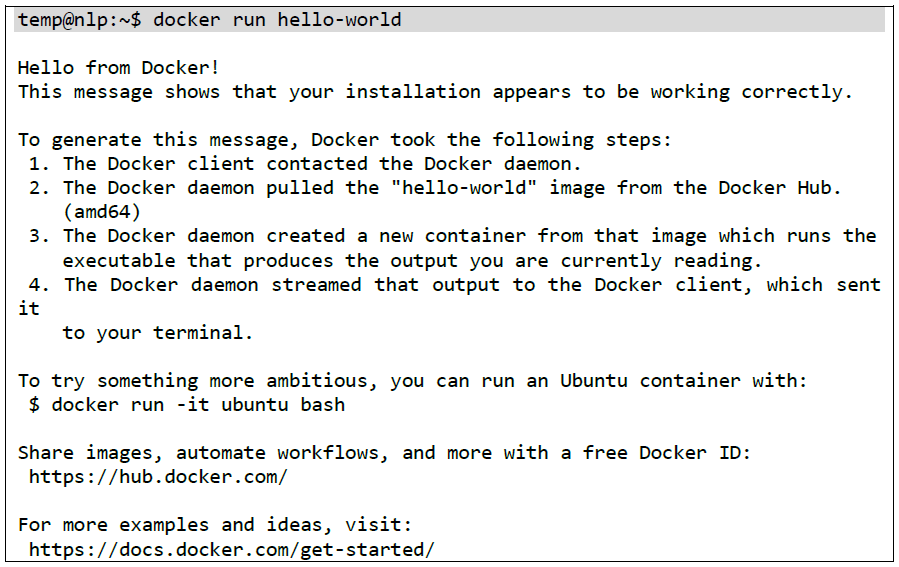

4. Installing Tensorflow to train the BERT model for conversational AI (NLP)

5. Installing Triton Inference Server to serve the trained BERT model

For more details and enquiries about NVIDIA Products, including NVIDIA Launchpad and NVIDIA AI Enterprise, please contact our sales team at:





